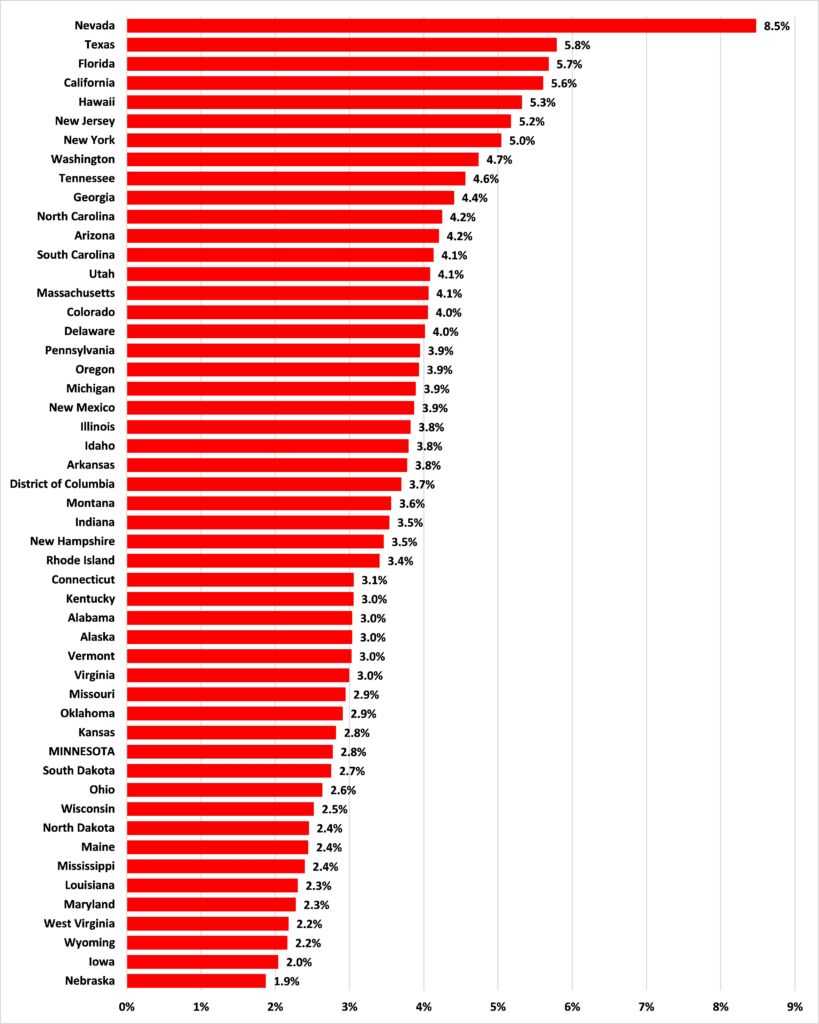If Minnesota is such a great state for business, why aren’t businesses and employees acting like it?
Minnesota’s media is always on the lookout for good news stories about the state, which might explain the coverage given to our ranking of 5th in CNBC’s annual “America’s Top States for Business.”
But if Minnesota is such a great state for business, why do we not see this reflected in the actions of the businesses themselves?
Business formation
If Minnesota is such a top state for business, we should expect to see more businesses being started here than in other states.
But we do not. The Census Bureau data on Annual Business Applications show that, in 2022, the number of new business applications in Minnesota declined by 6.2%, joint 37th out of the fifty states and District of Columbia, as Figure 1 shows.
Figure 1: Change in Annual Business Application, 2021-2022

There is no statistically significant relationship between the change in a state’s Annual Business Applications from 2021 to 2022 and its ranking on the 2023 CNBC America’s Top States for Business rankings.
Job creation
If Minnesota is such a top state for business, we should expect to see the businesses it does have creating jobs at a rate above the average.
Again, we do not. I have often highlighted the difference between data for the number of jobs and the number of people employed, usually to focus on the latter. Here I want to focus on the former as a measure of business vitality in the state. The Bureau of Labor Statistics’ Current Employment Statistics show that in 2022, the number of jobs in Minnesota increased by 2.8%, joint 39th out of the fifty states and District of Columbia, as Figure 2 shows.
Figure 2: Change in nonfarm payrolls, 2021-2022

There is a statistically significant relationship between the change in a state’s nonfarm payrolls from 2021 to 2022 and its ranking on the 2023 CNBC America’s Top States for Business rankings.
Investment
If Minnesota is such a top state for business, we should expect to see the businesses it does have investing in capital at a rate above the average.
Again, we do not. Estimates of state capital stocks — which we can turn into estimates of capital per job — show that, in 2021 (the most recent year for which we have data), capital per job in Minnesota fell by 1.9%, ranking 21st out of the fifty states and District of Columbia, as Figure 3 shows.
Figure 3: Real change in capital per worker, 2020 to 2021

There is no statistically significant relationship between the change in a state’s stock of capital per job from 2020 to 2021 and its ranking on the 2023 CNBC America’s Top States for Business rankings.
Attracting workers
One commentary on CNBC’s rankings conceded that Minnesota fares poorly “in categories conservatives like to lean on like “Cost of Doing Business” (39th) and “Business Friendliness” (30th).” Well, it it does purport to be a ranking of America’s Top States for Business so measures relating to business ought to figure prominently whatever your political ideology.
But, the commentary continued:
…as CNBC pointed out, “states are clamoring for workers.” And the belief is by making your state attractive for workers — not just owners — you make it attractive for business.
…
But the problem with looking at business strictly from a political viewpoint, as O’Leary and other conservatives do, is that it doesn’t take into account workforce, education and other factors that matter. Businesses need employees and increasingly young employees are looking for assets outside of their jobs.
This is why, apparently, CNBC was justified in including measures of things like abortion access in its business rankings, and with equal weight to measures like “Cost of Doing Business.”
So, if all these non-business related factors make Minnesota a top state for business by attracting workers, we should expect to see people flocking to the state from elsewhere in the United States.
And, again, we do not. As I’ve noted before, from mid-2021 to mid-2022, 19,400 Minnesota residents fled for other states, as Figure 4 shows, by far the highest number in at least three decades.
Figure 4: Net domestic migration, 2022

And — you guessed it — there is no statistically significant relationship between a state’s net domestic migration from 2021 to 2022 and its ranking on the 2023 CNBC America’s Top States for Business rankings.
Rankings schmankings
Looking at the evidence, we might be justified in deciding that CNBC’s rankings of America’s Top States for Business are completely useless. They do not correlate in any statistically significant way with what businesses actually do — form and invest — nor with where workers choose to move to.
If you want to know which states really are America’s top states for business, don’t look at these sorts of rankings, look at the data.